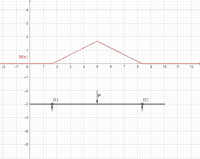Carultch
Senior Member
- Location
- Massachusetts
When you leave the load distribution completely open-ended, there is no conclusive location for optimizing the support points. You need some definition of the load distribution as a starting point.OK, so if your beam member is only subjected to uniform loads, I get that the support points should be (sqrt(2)-1)/2 of the way in from each end, which agrees with your statement that the distance between supports is 1/1.71 of the beam length.
But if you expand the allowable loading cases to any distributed loading up to some maximum limit over any subset of the beam, then to minimize the maximum moment the support points should be 1/4 of the way in. That way the moment at the support from just loading the cantilever (which moment will be independent of the loading on the rest of the beam) equals in magnitude the moment at the beam midpoint from just loading the central span (with no load on the cantilevers).
Or switching gears slightly, if the allowable loading cases consist of a single point load anywhere along the beam, then the optimal support location is 1/6 of the way in from the end. That way the maximum moment from the point load being at the end of the beam will be equal in magnitude to the maximum moment from the point load being at the midpoint of the beam.
Cheers, Wayne
The quarter points would optimize strength, given a uniform load on any given segment, and no load on all the other segments, with segments defined by the ends and support points. This is unlikely in reality, because it'd require that the loading distribution abruptly drops from uniform to zero after crossing a support, when there's no causal reason why this would be the case.
You are correct with your example of a point load at any variable location. An application of this, would be a load-bearing trolley that needs to glide along a rail of negligible weight, and one that can glide past the support points. Cantilevers of L/6, and a span of 2L/3, give the ideal locations that minimizes the worst case bending moment, which either occurs when the load is at the very beginning, or the very middle of the span. I made a Geogebra page, with a slider that allows you to see how the load position and support span affects the bending moment diagram. Adjust Xp to move the point load, and adjust s to modify the span.



